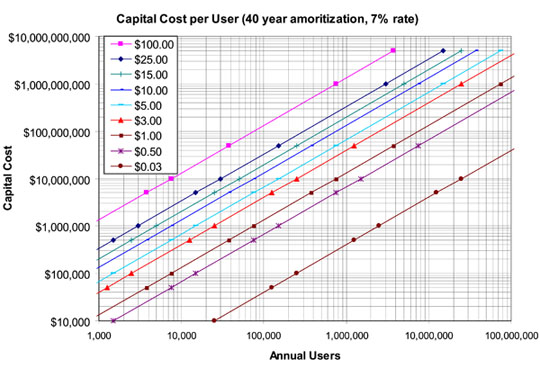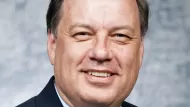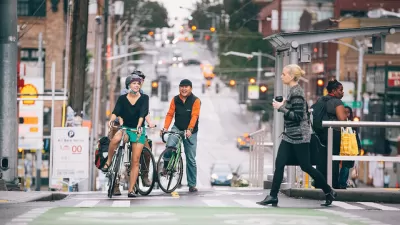I’ve been torn lately between two contradictory perspectives on the state of the country as it relates to providing transportation infrastructure and service.
I've been torn lately between two contradictory perspectives on the state of the country as it relates to providing transportation infrastructure and service. On the one hand, I am completely convinced that Americans are under investing in transportation. We have benefited from the prudence of our predecessors who had the foresight to invest in infrastructure and establish trust funds and other mechanisms that have resulted in the best mobility in the world. We've seen the pictures of men toiling in the hot sun to build transcontinental railroads, major bridges, or roads through swamps and mountain passes so we could all benefit from the mobility these investments provide. In real terms, our predecessors spent far more on transportation and thus managed to build infrastructure for themselves and the next generation. By almost any measure we now under price and under invest in transportation.
Meanwhile, we are caught in our own swamp of paper and process and are unable to reach consensus on a path forward. Maybe we are all too selfish – we can afford big SUVs and 300+ horsepower cars, but have isolated travelers from the reality of dramatically higher transportation project costs by shunning taxes and fees with a resoluteness that would make Pavlov proud. We have acquiesced to speculators and international energy markets that cause fuel prices to jump on rumors and whims, but fail to realize that fuel tax proposals are dwarfed by the magnitude of energy cost increases. It is common to see folks drive around on $2,000 oversized alloy wheels and skinny high-priced tires, pay $1,500 for a navigation system instead of $1.75 for a map, and spend thousands on sunroofs, stereos or running boards, while bemoaning the cost of fuel.
There are a boatload of rationalizations. Many pundits presume that everything government touches is fraught with waste - if only there were disciplined spending, we would have plenty of money! Others seem to think that if you don't build it, they won't come - if we simply quit investing in transportation, particularly anything that accommodates vehicles, it will translate into less demand and force those slothful folks to use alternatives. Others envision the crisis as an opportunity to leverage the private sector – or at least outsource the task of raising fees to the private sector. Fresh off having housing developers and hedge funds wreak havoc with our economy, many are cheerleading the privatization of roadways. The congestion on our transportation system is surpassed only by the queue of developers and airlines in bankruptcy court - so privatization must be the answer. At each level of government, officials look up and down the chain of governance in search of someone to blame for the lack of resources, each thinking, "They should solve this, and we better get our fare share of resources."
We have managed to blink and nod at our crises in Social Security, immigration, health care, and education; so why, pray tell, would transportation rise above the fray? Maybe we can restore the balance in the transportation trust funds by earmarking defense bills.
On the other hand, I am increasingly convinced our professional lust for transportation investment exceeds the public's, and quite possibly exceeds prudence. Perhaps transportation professionals have been drinking their own Kool Aid. We seldom meet a project that is too expensive, only ones that are not adequately funded. We define every shortfall as a need for additional revenues instead of an opportunity to rethink the project. The zeal to appeal to a plethora of constituencies has resulted in big price tags but modest capacity. As costs have gone up dramatically, how have we modified our design standards, procurement processes, and project selection criteria to reflect this new reality? If the cost of a project increases 50 to 100 percent, just maybe we need to reevaluate the solution not roll the project into another year of the work program. Those fundamental skills of systematic thinking and problem solving we learned in school are quickly forgotten as we embrace each new fad with the zeal of an infomercial host. The menu of solutions keeps changing - coordinated, multimodal, comprehensive, integrated, intelligent, privatized, managed, intermodal and, of course, sustainable. In the meantime, we often fail to adapt our solutions to the reality of today's costs, travel behavior, business and cultural environment, and a realistic reflection of public will and willingness to pay.
Some years ago, I put together a simple graph that puts the cost and use of a transportation investment in perspective. By finding the capital cost on the vertical axis and the annual users on the horizontal axis, the intersecting point shows the approximate cost per user by extrapolating between the diagonal lines, e.g., spending $1 billion on a project that serves 750,000 users annually results in a capital cost per user of $100. The lower diagonal line at $0.03 is roughly equivalent to the average fuel tax per vehicle mile equivalent that we currently charge at the federal, state, and local levels combined.

So, dig out the work plan and check out those projects. On a project by project basis how are you doing? On an overall program basis? Could we be over investing in individual projects and under investing in transportation? If we get the project costs and values in reasonable proportion, it will be a lot easier to make the case for the necessary revenues to meet transportation needs. And, as for determining "reasonable proportion" – think about what you would want to stand to defend in front of a room of voters and your grandchildren. Maybe it is time for more dollars and change. Good luck.

Maui's Vacation Rental Debate Turns Ugly
Verbal attacks, misinformation campaigns and fistfights plague a high-stakes debate to convert thousands of vacation rentals into long-term housing.

Planetizen Federal Action Tracker
A weekly monitor of how Trump’s orders and actions are impacting planners and planning in America.

In Urban Planning, AI Prompting Could be the New Design Thinking
Creativity has long been key to great urban design. What if we see AI as our new creative partner?

Portland Raises Parking Fees to Pay for Street Maintenance
The city is struggling to bridge a massive budget gap at the Bureau of Transportation, which largely depleted its reserves during the Civd-19 pandemic.

Spokane Mayor Introduces Housing Reforms Package
Mayor Lisa Brown’s proposals include deferring or waiving some development fees to encourage more affordable housing development.

Houston Mayor Kills Another Bike Lane
The mayor rejected a proposed bike lane in the Montrose district in keeping with his pledge to maintain car lanes.
Urban Design for Planners 1: Software Tools
This six-course series explores essential urban design concepts using open source software and equips planners with the tools they need to participate fully in the urban design process.
Planning for Universal Design
Learn the tools for implementing Universal Design in planning regulations.
Gallatin County Department of Planning & Community Development
Heyer Gruel & Associates PA
JM Goldson LLC
City of Camden Redevelopment Agency
City of Astoria
Transportation Research & Education Center (TREC) at Portland State University
Jefferson Parish Government
Camden Redevelopment Agency
City of Claremont





























